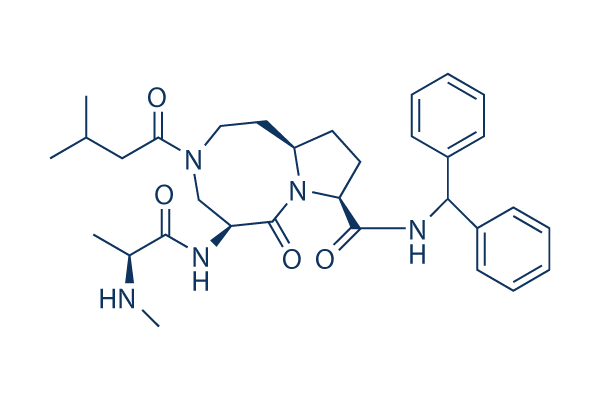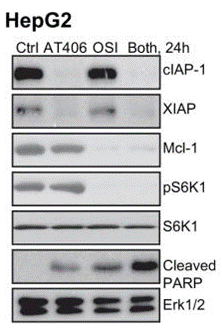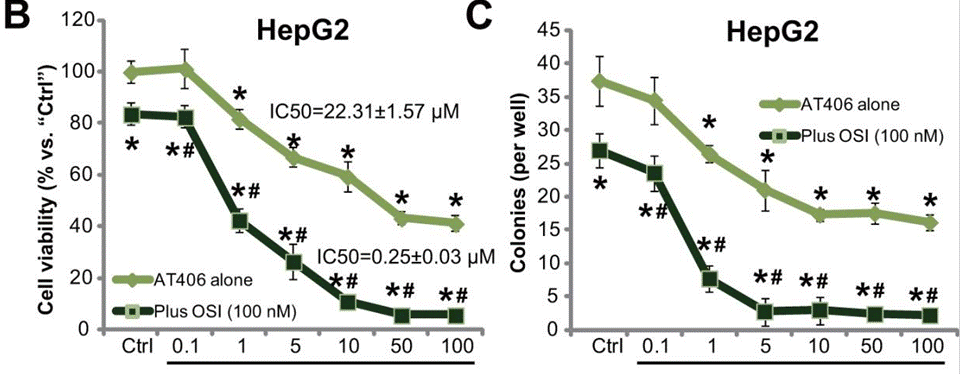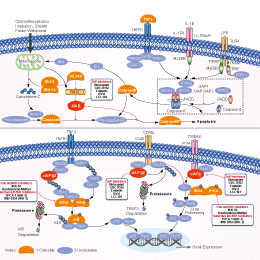
- Bioactive Compounds
- By Signaling Pathways
- PI3K/Akt/mTOR
- Epigenetics
- Methylation
- Immunology & Inflammation
- Protein Tyrosine Kinase
- Angiogenesis
- Apoptosis
- Autophagy
- ER stress & UPR
- JAK/STAT
- MAPK
- Cytoskeletal Signaling
- Cell Cycle
- TGF-beta/Smad
- DNA Damage/DNA Repair
- Compound Libraries
- Popular Compound Libraries
- Customize Library
- Clinical and FDA-approved Related
- Bioactive Compound Libraries
- Inhibitor Related
- Natural Product Related
- Metabolism Related
- Cell Death Related
- By Signaling Pathway
- By Disease
- Anti-infection and Antiviral Related
- Neuronal and Immunology Related
- Fragment and Covalent Related
- FDA-approved Drug Library
- FDA-approved & Passed Phase I Drug Library
- Preclinical/Clinical Compound Library
- Bioactive Compound Library-I
- Bioactive Compound Library-Ⅱ
- Kinase Inhibitor Library
- Express-Pick Library
- Natural Product Library
- Human Endogenous Metabolite Compound Library
- Alkaloid Compound LibraryNew
- Angiogenesis Related compound Library
- Anti-Aging Compound Library
- Anti-alzheimer Disease Compound Library
- Antibiotics compound Library
- Anti-cancer Compound Library
- Anti-cancer Compound Library-Ⅱ
- Anti-cancer Metabolism Compound Library
- Anti-Cardiovascular Disease Compound Library
- Anti-diabetic Compound Library
- Anti-infection Compound Library
- Antioxidant Compound Library
- Anti-parasitic Compound Library
- Antiviral Compound Library
- Apoptosis Compound Library
- Autophagy Compound Library
- Calcium Channel Blocker LibraryNew
- Cambridge Cancer Compound Library
- Carbohydrate Metabolism Compound LibraryNew
- Cell Cycle compound library
- CNS-Penetrant Compound Library
- Covalent Inhibitor Library
- Cytokine Inhibitor LibraryNew
- Cytoskeletal Signaling Pathway Compound Library
- DNA Damage/DNA Repair compound Library
- Drug-like Compound Library
- Endoplasmic Reticulum Stress Compound Library
- Epigenetics Compound Library
- Exosome Secretion Related Compound LibraryNew
- FDA-approved Anticancer Drug LibraryNew
- Ferroptosis Compound Library
- Flavonoid Compound Library
- Fragment Library
- Glutamine Metabolism Compound Library
- Glycolysis Compound Library
- GPCR Compound Library
- Gut Microbial Metabolite Library
- HIF-1 Signaling Pathway Compound Library
- Highly Selective Inhibitor Library
- Histone modification compound library
- HTS Library for Drug Discovery
- Human Hormone Related Compound LibraryNew
- Human Transcription Factor Compound LibraryNew
- Immunology/Inflammation Compound Library
- Inhibitor Library
- Ion Channel Ligand Library
- JAK/STAT compound library
- Lipid Metabolism Compound LibraryNew
- Macrocyclic Compound Library
- MAPK Inhibitor Library
- Medicine Food Homology Compound Library
- Metabolism Compound Library
- Methylation Compound Library
- Mouse Metabolite Compound LibraryNew
- Natural Organic Compound Library
- Neuronal Signaling Compound Library
- NF-κB Signaling Compound Library
- Nucleoside Analogue Library
- Obesity Compound Library
- Oxidative Stress Compound LibraryNew
- Plant Extract Library
- Phenotypic Screening Library
- PI3K/Akt Inhibitor Library
- Protease Inhibitor Library
- Protein-protein Interaction Inhibitor Library
- Pyroptosis Compound Library
- Small Molecule Immuno-Oncology Compound Library
- Mitochondria-Targeted Compound LibraryNew
- Stem Cell Differentiation Compound LibraryNew
- Stem Cell Signaling Compound Library
- Natural Phenol Compound LibraryNew
- Natural Terpenoid Compound LibraryNew
- TGF-beta/Smad compound library
- Traditional Chinese Medicine Library
- Tyrosine Kinase Inhibitor Library
- Ubiquitination Compound Library
-
Cherry Picking
You can personalize your library with chemicals from within Selleck's inventory. Build the right library for your research endeavors by choosing from compounds in all of our available libraries.
Please contact us at [email protected] to customize your library.
You could select:
- Antibodies
- Bioreagents
- qPCR
- 2x SYBR Green qPCR Master Mix
- 2x SYBR Green qPCR Master Mix(Low ROX)
- 2x SYBR Green qPCR Master Mix(High ROX)
- Protein Assay
- Protein A/G Magnetic Beads for IP
- Anti-Flag magnetic beads
- Anti-Flag Affinity Gel
- Anti-Myc magnetic beads
- Anti-HA magnetic beads
- Magnetic Separator
- Poly DYKDDDDK Tag Peptide lyophilized powder
- Protease Inhibitor Cocktail
- Protease Inhibitor Cocktail (EDTA-Free, 100X in DMSO)
- Phosphatase Inhibitor Cocktail (2 Tubes, 100X)
- Cell Biology
- Cell Counting Kit-8 (CCK-8)
- Animal Experiment
- Mouse Direct PCR Kit (For Genotyping)
- New Products
- Contact Us
Xevinapant (AT406)
Synonyms: ARRY-334543, Debio1143, SM-406
Xevinapant (AT406, ARRY-334543, Debio1143, SM-406) is a potent Smac mimetic and an antagonist of IAP (inhibitor of apoptosis protein via E3 ubiquitin ligase), binding to XIAP-BIR3, cIAP1-BIR3 and cIAP2-BIR3 with Ki of 66.4 nM, 1.9 nM, and 5.1 nM, 50- to 100-fold higher affinities than the Smac AVPI peptide. Phase 1.

Xevinapant (AT406) Chemical Structure
CAS No. 1071992-99-8
Purity & Quality Control
Batch:
Purity:
99.96%
99.96
Xevinapant (AT406) Related Products
| Related Targets | cIAP XIAP | Click to Expand |
|---|---|---|
| Related Products | Birinapant BV-6 LCL161 GDC-0152 AZD5582 SM-164 Tolinapant (ASTX660) | Click to Expand |
| Related Compound Libraries | Autophagy Compound Library Apoptosis Compound Library Ferroptosis Compound Library Pyroptosis Compound Library Mitochondria-Targeted Compound Library | Click to Expand |
Signaling Pathway
Cell Data
| Cell Lines | Assay Type | Concentration | Incubation Time | Formulation | Activity Description | PMID |
|---|---|---|---|---|---|---|
| EVSA-T | Cytotoxicity assay | 72 hrs | Cytotoxicity against human sensitive EVSA-T cells assessed as inhibition of cell growth after 72 hrs by Alamar Blue assay, EC50 = 0.0021 μM. | 26218264 | ||
| MDA-MB-231 | Cytotoxicity assay | 72 hrs | Cytotoxicity against human sensitive MDA-MB-231 cells assessed as inhibition of cell growth after 72 hrs by Alamar Blue assay, EC50 = 0.019 μM. | 26218264 | ||
| HEK293 | Function assay | 2 hrs | Antagonist activity at full-length FLAG-tagged XIAP (unknown origin) transfected in HEK293 cells assessed as inhibition of interaction with caspase 9 after 2 hrs by immunoprecipitation assay, EC50 = 0.034 μM. | 26218264 | ||
| SKOV3 | Growth inhibition assay | 4 days | Growth inhibition of human SKOV3 cells after 4 days by WST8 assay, IC50 = 0.142 μM. | 21443232 | ||
| MDA-MB-231 | Growth inhibition assay | 4 days | Growth inhibition of human MDA-MB-231 cells after 4 days by WST8 assay, IC50 = 0.144 μM. | 21443232 | ||
| MDA-MB-231 | Function assay | 10 nM | Induction of degradation of cIAP1 in human MDA-MB-231 cells at 10 nM by Western blot analysis | 21443232 | ||
| MDA-MB-231 | Function assay | 100 nM | 15 mins | Induction of degradation of cIAP1 in human MDA-MB-231 cells at 100 nM after 15 mins by Western blot analysis | 21443232 | |
| MDA-MB-231 | Apoptosis assay | 1.5 uM | 12 hrs | Induction of apoptosis in human MDA-MB-231 cells assessed as activation of caspase-3 activity at 1.5 uM after 12 hrs by Western blot analysis | 21443232 | |
| MDA-MB-231 | Apoptosis assay | 1.5 uM | 12 hrs | Induction of apoptosis in human MDA-MB-231 cells assessed as activation of PARP cleavage at 1.5 uM after 12 hrs by Western blot analysis | 21443232 | |
| MDA-MB-231 | Antitumor assay | 30 mg/kg | 2 weeks | Antitumor activity against human MDA-MB-231 cells xenografted in SCID mouse assessed inhibition of tumor growth at 30 mg/kg, po administered daily for 5 days/week for 2 weeks | 21443232 | |
| MDA-MB-231 | Antitumor assay | 100 mg/kg | 2 weeks | Antitumor activity against human MDA-MB-231 cells xenografted in SCID mouse assessed inhibition of tumor growth at 100 mg/kg, po administered daily for 5 days/week for 2 weeks | 21443232 | |
| MDA-MB-231 | Antitumor assay | 100 mg/kg | every 3 days | Antitumor activity against human MDA-MB-231 cells xenografted in Balb/c SCID mouse assessed as tumor growth inhibition at 100 mg/kg, po qd measured every 3 days | 26218264 | |
| DAOY | qHTS assay | qHTS of pediatric cancer cell lines to identify multiple opportunities for drug repurposing: Primary screen for DAOY cells | 29435139 | |||
| SJ-GBM2 | qHTS assay | qHTS of pediatric cancer cell lines to identify multiple opportunities for drug repurposing: Primary screen for SJ-GBM2 cells | 29435139 | |||
| A673 | qHTS assay | qHTS of pediatric cancer cell lines to identify multiple opportunities for drug repurposing: Primary screen for A673 cells | 29435139 | |||
| SK-N-MC | qHTS assay | qHTS of pediatric cancer cell lines to identify multiple opportunities for drug repurposing: Primary screen for SK-N-MC cells | 29435139 | |||
| BT-37 | qHTS assay | qHTS of pediatric cancer cell lines to identify multiple opportunities for drug repurposing: Primary screen for BT-37 cells | 29435139 | |||
| NB-EBc1 | qHTS assay | qHTS of pediatric cancer cell lines to identify multiple opportunities for drug repurposing: Primary screen for NB-EBc1 cells | 29435139 | |||
| Saos-2 | qHTS assay | qHTS of pediatric cancer cell lines to identify multiple opportunities for drug repurposing: Primary screen for Saos-2 cells | 29435139 | |||
| LAN-5 | qHTS assay | qHTS of pediatric cancer cell lines to identify multiple opportunities for drug repurposing: Primary screen for LAN-5 cells | 29435139 | |||
| BT-12 | qHTS assay | qHTS of pediatric cancer cell lines to identify multiple opportunities for drug repurposing: Primary screen for BT-12 cells | 29435139 | |||
| OHS-50 | qHTS assay | qHTS of pediatric cancer cell lines to identify multiple opportunities for drug repurposing: Primary screen for OHS-50 cells | 29435139 | |||
| SK-N-MC | qHTS assay | qHTS of pediatric cancer cell lines to identify multiple opportunities for drug repurposing: Confirmatory screen for SK-N-MC cells | 29435139 | |||
| TC32 | qHTS assay | qHTS of pediatric cancer cell lines to identify multiple opportunities for drug repurposing: Confirmatory screen for TC32 cells | 29435139 | |||
| Click to View More Cell Line Experimental Data | ||||||
Biological Activity
| Description | Xevinapant (AT406, ARRY-334543, Debio1143, SM-406) is a potent Smac mimetic and an antagonist of IAP (inhibitor of apoptosis protein via E3 ubiquitin ligase), binding to XIAP-BIR3, cIAP1-BIR3 and cIAP2-BIR3 with Ki of 66.4 nM, 1.9 nM, and 5.1 nM, 50- to 100-fold higher affinities than the Smac AVPI peptide. Phase 1. | ||||||
|---|---|---|---|---|---|---|---|
| Targets |
|
| In vitro | ||||
| In vitro | AT-406 is a Smac mimetic and appears to mimic closely the AVPI peptide in both hydrogen bonding and hydrophobic interactions with XIAP, with additional hydrophobic contacts with W323 of XIAP. AT-406 is more sensitive to these IAPs than Smac AVPI peptide with 50-100 fold binding affinities. AT-406 (at 1 μM) completely restores the activity of caspase-9, which is suppressed by 500 nM XIAP BIR3 in a cell-free system. In MDA-MB-231 cell, AT-406 induces rapid cellular cIAP1 degradation and also pulls down the cellular XIAP protein. AT-406 effectively inhibits lots of human cancer cell lines and shows IC50 of 144 and 142 nM in MDA-MB-231 cell and SK-OV-3 ovarian cell, with low toxicity against normal-like human breast epithelial MCF-12F cells and primary human normal prostate epithelial cells. AT-406 induces apoptosis in MDA-MB-231 cell by inducing activation of caspase-3 and cleavage of PARP. [1] | |||
|---|---|---|---|---|
| Kinase Assay | Fluorescence Polarization Based Assays for XIAP, cIAP1, and cIAP2 BIR3 Proteins | |||
| FL-AT-406 (the fluorescently tagged AT-406) is employed to develop a set of new FP assays for determination of the binding affinities of Smac mimetics to XIAP, cIAP-1, and cIAP-2 BIR3 proteins. The Kd value of FL-AT-406 to each IAP protein is determined by titration experiments using a fixed concentration of FL-AT-406 and different concentrations of the protein up to full saturation. Fluorescence polarization values are measured using an Infinite M-1000 plate reader in Microfluor 2 96-well, black, round-bottom plates. To each well, FL-AT-406 (2, 1, and 1 nM for experiments with XIAP BIR3, cIAP-1 BIR3, and cIAP-2 BIR3, respectively) and different concentrations of the protein are added to a final volume of 125 μL in the assay buffer (100 mM potassium phosphate, pH 7.5, 100 μg/mL bovine γ-globulin, 0.02% sodium azide, with 4% DMSO). Plates are mixed and incubated at room temperature for 2-3 hours with gentle shaking. The polarization values in millipolarization units (mP) are measured at an excitation wavelength of 485 nm and an emission wavelength of 530 nm. Equilibrium dissociation constants (Kd) are then calculated by fitting the sigmoidal dose-dependent FP increases as a function of protein concentrations using Graphpad Prism 5.0 software. In competitive binding experiments for XIAP3 BIR3, AT-406 is incubated with 20 nM XIAP BIR3 protein and 2 nM FL-AT-406 in the assay buffer (100 mM potassium phosphate, pH 7.5; 100 μg/mL bovine γ-globulin; 0.02% sodium azide). In competitive binding experiments for cIAP1 BIR3 protein, 3 nM protein and 1 nM FL-AT-406 are used. In competitive binding experiments for cIAP2 BIR3, 5 nM protein and 1 nM FL-AT-406 are used. For each competitive binding experiment, polarization values are measured after 2-3 hours of incubation using an Infinite M-1000 plate reader. The IC50 value, the inhibitor concentration at which 50% of the bound tracer is displaced, is determined from the plot using nonlinear least-squares analysis. Curve fitting is performed using the PRISM software. A Ki value for AT-406 is calculated. | ||||
| Cell Research | Cell lines | MDA-MB-231 breast cancer and SK-OV-3 ovarian cancer cell lines | ||
| Concentrations | ~ 1 μM | |||
| Incubation Time | 4 days | |||
| Method | Cells are seeded in 96-well flat bottom cell culture plates at a density of (3-4) × 103 cells/well with AT-406 and incubated for 4 days. The rate of cell growth inhibition after treatment with different concentrations of AT-406 is determined by assaying with (2-(2-methoxy-4-nitrophenyl)-3-(4-nitrophenyl)-5-(2,4-disulfophenyl)-2H-tetrazolium monosodium salt (WST-8). WST-8 is added to each well to a final concentration of 10%, and then the plates are incubated at 37 °C for 2−3 hours. The absorbance of the samples is measured at 450 nm using a TECAN ULTRA reader. Concentration of AT-406 that inhibited cell growth by 50% (IC50) is calculated by comparing absorbance in the untreated cells and the cells treated with AT-406. |
|||
| Experimental Result Images | Methods | Biomarkers | Images | PMID |
| Western blot | cIAP-1 / XIAP / Mcl-1 / pS6K1 / Cleaved PARP |

|
28036295 | |
| Growth inhibition assay | Cell viability |

|
28036295 | |
| In Vivo | ||
| In vivo | AT-406 has good pharmacokinetic (PK) properties and oral bioavailability in mice, rats, non-human primates, and dogs. In the MDA-MB-231 xenograft, AT-406 effectively induces cIAP1 degradation and processing of procaspase-8, cleavage of PARP in tumor tissues at 100 mg/kg with well toleration even at 200 mg/kg. AT-406 induces significant tumor growth inhibition with p of 0.0012 at 100 mg/kg. [1] | |
|---|---|---|
| Animal Research | Animal Models | MDA-MB-231 xenograft tumors in severe combined immune deficiency (SCID) mice |
| Dosages | 10 mg/kg (i.v.), 10 mg/kg (p.o.), 30 mg/kg (p.o.) and 100 mg/kg (p.o.) | |
| Administration | Administered via intravenously (i.v.) or oral gavage (p.o.) | |
| NCT Number | Recruitment | Conditions | Sponsor/Collaborators | Start Date | Phases |
|---|---|---|---|---|---|
| NCT01265199 | Terminated | Acute Myelogenous Leukemia (AML) |
Ascenta Therapeutics|The Leukemia and Lymphoma Society |
February 2011 | Phase 1 |
| NCT01078649 | Completed | Cancer|Solid Tumors|Lymphoma|Malignancy |
Debiopharm International SA |
March 29 2010 | Phase 1 |
Chemical Information & Solubility
| Molecular Weight | 561.71 | Formula | C32H43N5O4 |
| CAS No. | 1071992-99-8 | SDF | Download Xevinapant (AT406) SDF |
| Smiles | CC(C)CC(=O)N1CCC2CCC(N2C(=O)C(C1)NC(=O)C(C)NC)C(=O)NC(C3=CC=CC=C3)C4=CC=CC=C4 | ||
| Storage (From the date of receipt) | |||
|
In vitro |
DMSO : 112 mg/mL ( (199.39 mM) Moisture-absorbing DMSO reduces solubility. Please use fresh DMSO.) Ethanol : 112 mg/mL Water : Insoluble |
Molecular Weight Calculator |
|
In vivo Add solvents to the product individually and in order. |
In vivo Formulation Calculator |
||||
Preparing Stock Solutions
Molarity Calculator
In vivo Formulation Calculator (Clear solution)
Step 1: Enter information below (Recommended: An additional animal making an allowance for loss during the experiment)
mg/kg
g
μL
Step 2: Enter the in vivo formulation (This is only the calculator, not formulation. Please contact us first if there is no in vivo formulation at the solubility Section.)
% DMSO
%
% Tween 80
% ddH2O
%DMSO
%
Calculation results:
Working concentration: mg/ml;
Method for preparing DMSO master liquid: mg drug pre-dissolved in μL DMSO ( Master liquid concentration mg/mL, Please contact us first if the concentration exceeds the DMSO solubility of the batch of drug. )
Method for preparing in vivo formulation: Take μL DMSO master liquid, next addμL PEG300, mix and clarify, next addμL Tween 80, mix and clarify, next add μL ddH2O, mix and clarify.
Method for preparing in vivo formulation: Take μL DMSO master liquid, next add μL Corn oil, mix and clarify.
Note: 1. Please make sure the liquid is clear before adding the next solvent.
2. Be sure to add the solvent(s) in order. You must ensure that the solution obtained, in the previous addition, is a clear solution before proceeding to add the next solvent. Physical methods such
as vortex, ultrasound or hot water bath can be used to aid dissolving.
Tech Support
Answers to questions you may have can be found in the inhibitor handling instructions. Topics include how to prepare stock solutions, how to store inhibitors, and issues that need special attention for cell-based assays and animal experiments.
Tel: +1-832-582-8158 Ext:3
If you have any other enquiries, please leave a message.
* Indicates a Required Field
Tags: buy Xevinapant (AT406) | Xevinapant (AT406) supplier | purchase Xevinapant (AT406) | Xevinapant (AT406) cost | Xevinapant (AT406) manufacturer | order Xevinapant (AT406) | Xevinapant (AT406) distributor







































